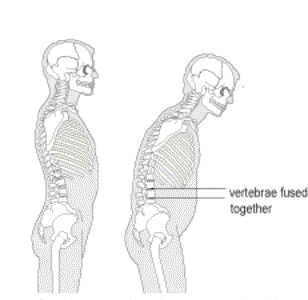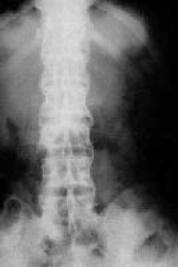Description:
- A chronic seronegative inflammatory disease
- affects the axial skeleton, especially the sacroiliac joints, hip joints, and spine
- extraskeletal involvement of aorta, lung, uvea
- Disease onset is during young adulthood, typically affecting adolescent boys
- HLA-B27surface antigen is found in 88-96% of patients
- Limited chest wall expansion best screening criteria
- Elevated ESR (sedimentation rate) is present in 80% of patients
- Serum creatine phosphokinase (CPK) is a good indicator of disease severity
- Investigators postulate that an endogenic component (HLA-B27) and an exogenic component (Klebsiella or Chlamydia) are responsible for triggering the disease.
Left: Normal posture and lumbar lordosis. Right: Loss of lumbar lordosis and posture in ankylosing spondylitis
Signs/Symptoms:
- Insidious onset
- Early symptoms of buttocks, heels, lower back pain
- Morning stiffness with improvement of symptoms throughout day
- Earliest changes involve sacroiliac (SI) joints
- Disease then extends up the spine
- Results in loss of spinal motion and lumbar lordosis
- Synovitis leads to progressive fibrosis and ankylosis of joints
- Enthesitis occurs where annulus fibrosis inserts on vertebral body with eventual calcification creating the characteristic “bamboo spine” (right)
- Uveitis and chest tightness affect 30% of patients
- Dilatation of aorta occurs in 5% of patients
- Associated with renal amyloidosis and pulmonary fibrosis
Imaging:
- Symmetric SI joint widening and subchondral erosions are first radiographic signs
- Loss of anterior concavity of vertebral body, or squaring of the vertebra
- Vertabral body marginal syndesmophyte formation (bone spurs connecting vertebral bodies – see red arrows) forming appearance of “bamboo spine”)
- Disease and radiographic findings begin in SI joints and progress cephalad
Treatment:
- Disease slowly progresses over several decades
- Initial treatment involves exercises, and non-steroidal anti-inflammatory medications
- 10% of patients require surgical intervention
- Hip disease should be addressed surgically prior to spine surgery
- Fixed bony flexion that limits ambulation and horizontal gaze after hip correction warrant surgical treatment
- Loss of lumbar lordosis can be treated with multilevel posterior closing wedge osteotomies – the Smith-Peterson procedure – or other techniques
- Spine is then fused in to corrected and more functional position
- Contraindications to surgery include poor general health and significant scarring of major vessels that may be injured when spine is extended



